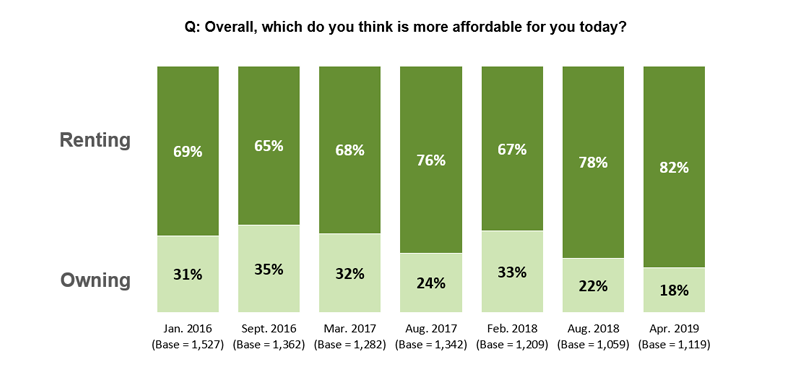A household's decision between buying a home and renting one is being increasingly determined by its student loan debt and childcare cost burdens according to results of a Freddie Mac survey of renters and homeowners. The survey of 4,000 households shows that affordability issues are continuing to have a profound impact on housing choices.
Freddie Mac president and new CEO says, "Our research confirms much of what we see in our business every day - affordability remains the essential factor when it comes to determining whether to rent or purchase a home, and the cost of housing is having a significant impact on households of every age, size and location. For millennials and many Gen Xers, buying a home is no longer just a decision based on housing and housing costs - increasing pressure from student loans and the rising cost of childcare are having a significant impact."
The survey found that whether respondents owned their home or were renting, they did so because they believed it was the more affordable option for them. However, both groups increasingly see renting as more affordable. Eighty-two percent of renters now view renting as more affordable than homeownership, up 15 points from February 2018 and an all-time high for the survey.

Even as the vast majority of those questioned believed their choices were the most affordable, the survey found renters were more likely to be cost-burdened. Thirty-four percent of renters spend more than one-third of their income on rent, compared to a quarter of homeowners with their mortgages. Homeowning Baby Boomers are the least likely to be cost-burdened with only 17 percent spending more than a third of their income on housing verses 41 percent of renters.
Nearly nine of ten (88 percent) low-income renters said that having the money for a down payment and closing costs would be an obstacle to homeownership, an opinion shared by 72 percent of middle-income renters. Of these groups, 62 percent of low-income and 39 percent of middle-income renters called having this obstacle a "major" one. It was also a cross-generational issue. Four of five Millennials and Gen Xers and 71 percent of Boomers perceive their lack of upfront homebuying funds an obstacle to homeownership.
Many renters also think that mortgage payments would be higher than their rent payments This was perceived as a major obstacle to owning by 40 percent of renters with female renters much more likely than their male counterparts (48 verses 28 percent) to consider mortgage payments an obstacle.
Freddie Mac says one of its survey's more dramatic findings was that slightly more than half of both renters and homeowners have made changes over the last two years to afford their monthly housing payments, including 62 percent of renters and 47 percent of homeowners.
Among these renters, 55 percent said they have reduced spending on non-essential items, such as entertainment, while 42 percent spent less on food, utilities and other essentials over the past two years. A surprising 44 percent of renters with affordability issues over the past two years said they had been forced to move by this problem, a 14-point jump over the August 2018 survey findings.
Of homeowners who had made changes, 52 percent spent less on non-essentials while a third had cut back on food, utilities, and other essentials. Moreover, 35 percent reported having to move over the past year for more affordable housing, a 9-point increase since last August.
In addition, the survey finds renters and owners also made housing decisions based their childcare costs, such as daycare and the proximity to daycare and/or due to student loan debt. In the case of both drivers, those in the essential workforce, serving in crucial positions like health care, education and law enforcement, were more likely to be faced with these decisions than those in the non-essential workforce.
A just over half of Millennial renters under the age of 30 had made different housing choices because of their student loans compared with 38 percent of that age group who were homeowners. The same was true of 41 percent of older Millennials (aged 30-38) who rent. Among essential employees 51% of owners and 53% of renters had made decisions with student loan debt in mind.
Half of owners and 44 percent of renters in the essential workforce said they had to make different choices to afford day care. The top decisions included choosing a less expensive home (26 percent of owners, 21 percent of renters); postponing buying a home (24 percent and 15 percent); or choosing a lower-cost area to live in (23 percent and 22 percent). In the non-essential workforce fewer than 15 percent of either owners or renters claim childcare costs motivated decisions.
Brickman added, "While we tend to focus primarily on wages not keeping up with house prices and misperceptions of down payments, we should also recognize that for many millennials and Gen Xers, the basic cost of living has gone up. Heavy burdens from student loans and the rapidly rising cost of childcare are clearly affecting the housing decisions of these individuals. Given these challenges, it's not surprising that more than one-third of survey respondents believe ownership is becoming less accessible."
The affordability survey was conducted over a four-day period in April with 2,864 homeowners, 1,119 renters, and 57 "others. The data was weighted to reflect the composition of the U.S. adult population.







